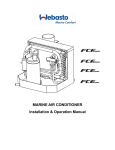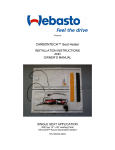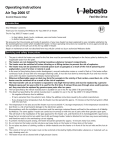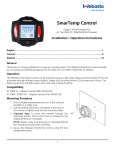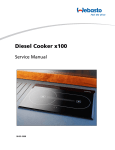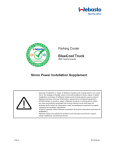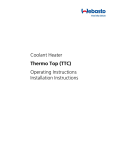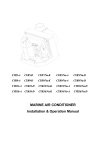Download Webasto FCF 9 Specifications
Transcript
FEEL COOL FAST MARINE AIR CONDITIONER Installation & Operation Manual 6/2012 Table of Contents INTRODUCTION ................................................................................................................................................. 4 PACKAGED COMPONENTS .............................................................................................................................. 5 OVERVIEW ......................................................................................................................................................... 5 INSTALLATION ................................................................................................................................................... 6 Unpacking and Inspection ....................................................................................................................................... 6 Safety Considerations ............................................................................................................................................. 6 Placement of System ............................................................................................................................................... 7 Blower Assembly ..................................................................................................................................................... 9 Mounting Brackets ................................................................................................................................................... 9 Supply & Return Air Grilles and Transition Boxes.................................................................................................... 9 Ducting .................................................................................................................................................................. 10 Seawater Pump and Plumbing .............................................................................................................................. 10 Electrical Connections, Grounding and Bonding ................................................................................................... 12 Digital Display Installation ...................................................................................................................................... 13 Electric Box Installation.......................................................................................................................................... 13 Installation Checklist (Review Prior To Installation) ............................................................................................... 14 Wiring Diagrams .................................................................................................................................................... 15 OPERATION...................................................................................................................................................... 18 Digital Display Operation ....................................................................................................................................... 18 Power ON/OFF.......................................................................................................................................................... 19 Sleep Mode of the digital display ............................................................................................................................... 19 FAN Control ............................................................................................................................................................... 19 Temperature Setting ................................................................................................................................................... 19 Mode Setting .............................................................................................................................................................. 19 Button / Function and Description (Cover Closed) ................................................................................................... 21 Button / Function and Description (Cover Open)...................................................................................................... 22 ERROR CODES ................................................................................................................................................ 24 TROUBLESHOOTING ...................................................................................................................................... 25 MAINTENANCE ................................................................................................................................................ 27 Reversing Valves ................................................................................................................................................... 27 Seawater Strainer .................................................................................................................................................. 27 Condenser Coil Cleaning (Seawater Acid Flush) .................................................................................................. 27 Return Air Filters .................................................................................................................................................... 27 Winterization .......................................................................................................................................................... 28 UNIT DIMENSIONS & TECHNICAL SPECIFICATIONS ................................................................................... 29 LIMITED WARRANTY ....................................................................................................................................... 30 TECHNICAL ASSISTANCE ............................................................................................................................... 30 Operation / Installation Manual – FCF 5000, 9000, 12000, 16000, 24000 Introduction Thank you for your purchase. No matter which of the following features was the reason for your purchase, we are sure it will meet your needs and give many years of efficient and trouble free use. These air conditioners are designed for marine applications incorporating the following features: • Compact design • High efficiency rotary compressors (5-24K) • Cupronickel condenser coil • Raised lance fin designed evaporator coil • Polyester coated 2” (50mm) deep drain pan with four condensate drain locations • Anti-vibration base pan • Pre-charged and pre-wired systems for easy connections • 3-speed fan motor. This eliminates all harmonic sounds and rumbles. • Rotatable blower assembly The controller offers the most technologically advanced design specifically made for the unique requirements of marine air conditioning. The controller has been designed with the following "user friendly" features: • Non-volatile memory • Low voltage display panel • LED cabin temperature displayed in Fahrenheit or Celsius • Multiple fan speed selections • Compressor pressure fail safe protection • Dehumidification Mode for humidity control This manual is intended to provide the information necessary to ensure proper installation, operation, and maintenance of a FCF air conditioner. Improper installation can result in unsatisfactory performance and/or premature failure. Before proceeding, please read this manual in its entirety. In the interest of product improvement, specifications and design are subject to change without prior notice. Page 4 Operation / Installation Manual – FCF 5000, 9000, 12000, 16000, 24000 Packaged Components ITEM QUANTITY Air Conditioning unit 1 Mounting Bracket 4 Fuses (3.15 AL 250V) 2 Remote controller / Batteries 1 Digital Display / Cable 1 Duct Ring / Hardware 1 Blower Insulation Foam 1 Installation / Operation Manual 1 Overview All units are manufactured without service ports HOW IT WORKS Your self-contained air conditioner consists of four main components and a refrigerant gas circulating through the system. The BLOWER draws warm cabin air across the fins on the EVAPORATOR where the heat from the air is transferred to the refrigerant in the evaporator coil. As the refrigerant evaporates from a liquid into a gas, it absorbs the heat from the cabin air. The COMPRESSOR then compresses the refrigerant gas and pumps it through the outer tube in the CONDENSER COIL. The seawater pump circulates cool seawater through the inner tube in the condenser coil; this cools the refrigerant and condenses it into a liquid. The heat from the refrigerant is exchanged to the seawater and discharged overboard. The liquid refrigerant is then passed through the EVAPORATOR COIL and the cycle repeats; removing heat from the cabin air lowering its temperature. The cooled air is blown through the ducting and out the supply air grille(s). For reverse cycle heating, the refrigerant flows in the opposite direction through the reversing valve. Heat is transferred from the seawater in the condenser coil to the refrigerant and then to the air blowing through the evaporator into the cabin. Seawater temperature will directly affect the air conditioners efficiency. This air conditioner can effectively cool your boat in water temperatures up to 90°F and heat in water temperatures as low as 40°F. Page 5 Operation / Installation Manual – FCF 5000, 9000, 12000, 16000, 24000 Installation Unpacking and Inspection When the equipment is received, all items should be carefully checked according to the packaged components list within this manual to ensure all components have been received. Examine components for shipping damage. If the unit is damaged, the carrier should make the proper notation on the delivery receipt acknowledging the damage. Safety Considerations VERY IMPORTANT: Never install your air conditioner in the bilge or engine room areas. Ensure that the selected location is sealed from direct access to bilge and/or engine room vapors. Do not terminate condensate drain line within 3’ (914mm) of any outlet of engine, generator exhaust system, compartment housing an engine or generator, or in a bilge, unless the drain is connected properly to a sealed condensate or shower sump pump. Seal all cabin penetrations around condensate hoses to eliminate harmful bilge fumes in the cabin living spaces. Installation and servicing of this system can be hazardous due to system pressure and electrical components. When working on this equipment, always observe precautions described in the literature, tags and labels attached to the unit. Follow all safety precautions. Wear safety glasses and work gloves and place a fire extinguisher close to the work area. The following is a summary of the labels on the unit: Indicates an imminently hazardous situation which, if not avoided, will result in death or serious injury. Indicates a potentially hazardous situation which, if not avoided, could result in death or serious injury. Indicates a potentially hazardous situation which, if not avoided, may result in minor or moderate injury. Special note. Make sure to read before proceeding. Electrical shock hazard. Disconnect voltage at main panel or power source before opening any cover. Failure to comply may result in injury or death. This component does not meet federal requirements for ignition protection. Do not install in spaces containing gasoline engines, tanks, LPG/CPG cylinders, regulators, valves or fuel line fittings. Failure to comply may result in injury or death. Notice the 115V series and the 230V series are charged with Hydro fluorocarbon (HFC) refrigerant R410A. Effective July 1, 1992, it shall be unlawful for any person to knowingly vent or otherwise knowingly release any class 1 (CFC) or class 2 (H CFC) substance as a refrigerant in a manner which permits such substance to enter the atmosphere per the clean air act of 1990. Public law 101-549 title IV section 608-c. Failure to comply may result in severe penalties, including fines and imprisonment. To minimize the hazard of electrical shock and personal injury, this component must be effectively grounded. Refer to the installation guidelines for further information. Caution! High compressor temperature is normal. Do not touch! Page 6 Operation / Installation Manual – FCF 5000, 9000, 12000, 16000, 24000 Placement of System Selecting a good location for your air conditioner is the most important part of your preparation. Be sure to consider the size of the area you are cooling, the air distribution needs, and the size of the unit you have chosen. Keeping in mind that cool air has a tendency to fall; it is highly recommended that you locate the supply air grille as high as possible in the cabin. The ducting should be run as straight, smooth and taut as possible minimizing the number of 90 degree bends. See diagram below. Size of Sealed room Ensure the area which the air conditioner is located is not too small otherwise it will affect proper operation. See the diagram below. Page 7 Operation / Installation Manual – FCF 5000, 9000, 12000, 16000, 24000 The unit should be installed as low as possible, BUT NEVER IN THE BILGE Tools required: OR ENGINE ROOM AREAS, ENSURE THAT THE SELECTED LOCATION • Screws drivers IS SEALED FROM DIRECT ACCESS TO BILGE AND/OR ENGINE ROOM • Pliers VAPORS. Installing the unit as low as possible (such as under a V-berth, • Pipe wrench dinette supply • Wire cutters/crimpers air as high as possible, creates an ideal airflow condition. This type of • Drill & bit set installation will prevent short or premature cycling. • Jigsaw • Duct tape • Electrical tape • Thread sealer • Bedding compound to seal thru seat or bottom of a locker) and ducting the The unit should be positioned on a firm, level, horizontal surface and the condensate drain line should run downward from the unit to a suitable drain location. Plan all Connections, which must be made including ducting, condensate drain, and seawater in and out, electrical power connections, location of control, and seawater pump placement, to assure easy access for routing and servicing. hull fittings • Hardware to secure unit, pump, strainer, grilles & electrical box Page 8 Operation / Installation Manual – FCF 5000, 9000, 12000, 16000, 24000 Condensate Drains The condensate drain pan is 2” (50mm) deep with four drain locations. During conditions of high humidity, condensate may be produced at a rate of approximately 1/2 gallon per hour (1.9 liters per hour). It is important to route condensate drains downward to a sump pump. It is not recommended to route condensate drains to the bilge. After the condensate drain installation is complete, test the installation by pouring water into the pan and checking for good flow. For installation of the condensate drain: ● Attach a 5/8” I.D. reinforced hose to the hose barb and secure with stainless steel hose clamps. ● Install the condensate drain hose downhill from the unit and aft to a sump. ● Four drain fittings may be used and the hoses joined together with a tee fitting provided there is a minimum 2" drop from the bottom of the base pan to the tee connection. Do not terminate condensate drain line within three 3’ (914mm) of any outlet of engine, generator exhaust systems, compartment housing an engine or generator, nor in a bilge, unless the drain is connected properly to a sealed condensate or shower sump pump. Seal all condensate hose penetrations. Blower Assembly You can achieve multi-directional supply air discharge from a single unit by rotating the blower to the desired position in 45° increments. It is ideal for tight installations as 360° of rotation is available with which to position the blower. Its advanced design allows the blower to be easily removed for rotating or servicing by removing 4 screws. Rotate the blower to allow the most direct flow of air to the supply air grille. After the blower has been properly positioned, make sure to install the supplied strip of insulation foam around the collar to prevent condensation build up. Mounting Brackets The air conditioning unit is supplied with a base pan that also serves as a condensate pan. Mounting clip brackets (4) are provided to secure the base pan to a flat, horizontal surface. Hardware for the mounting clips must be provided by the installer as needed. Supply & Return Air Grilles and Transition Boxes Install the supply air grille as high as possible in a location that will provide uniform air distribution throughout the cabin. Grille louvers should be directed properly for best air flow. The return air grille should be installed as low and close to the air conditioner as possible to insure direct uninterrupted airflow to the evaporator. The return air grille should have a minimum four inches (4') of clearance in front of it, free from any furniture or other obstructions. In no instance should a supply air discharge be directed towards a return air grille, as this will cause the system to short cycle. Allow for adequate clearance behind the supply air grille(s) for the transition box and ducting connection. See the Maintenance section of this manual for return air filter cleaning instructions. Page 9 Operation / Installation Manual – FCF 5000, 9000, 12000, 16000, 24000 Ducting Good airflow is critical for the performance of the entire system. It is highly dependent on the quality of the ducting installation. The ducting should be run as straight, smooth and taut as possible minimizing the number of 90 degree bends (two tight 90° bends can reduce airflow by 25%). If a transition box is used, the total area of supply air ducts going out of the box should at least equal the area of the supply duct feeding the box. To calculate the square inch area of a round duct, multiply the radius by itself (r ) and multiply that number by 3.1416(π). The following is a summary of proper 2 ducting connections: 1. Pull back the fiberglass insulation exposing the inner Mylar duct hose. 2. Slide the Mylar duct hose around the mount ring until it bottoms out. 3. Screw 3 or 4 stainless steel sheet metal screws through the duct hose into the transition ring. Make sure to catch the wire in the duct hose with the heads of the screws. Use finish washers with the screws if necessary. Do not use band clamps, as the hose will slide off. 4. Wrap duct tape around the ducting and ring joint to prevent any air leaks. 5. Pull the insulation back up over the Mylar to the ring and tape this joint. 6. Remove excess ducting and use the same connection method at the supply air grille. All ducting should: ● Be insulated and appropriately sized for each application. ● Run as smoothly and taut as possible. ● Have as few bends or loops as possible. ● Be securely fastened to prevent sagging or chafing during vessel operation. ● Have all excess ducting lengths trimmed off. ● Not be flattened or kinked. ● Be properly protected against potential damage when routed through open areas or bulkheads. Seawater Pump and Plumbing Several guidelines should be followed during the installation of the seawater system. If the circulation pump is centrifugal and not self-priming, it must be mounted so that it is always at least 1’ (305mm) below the water line regardless of which tack the vessel is on. Pump may be mounted horizontally or vertically, however, the discharge must always be above the inlet. Pump head should be rotated toward the direction of water flow. Install the seawater speed scoop intake as far below the water line and as close to the keel as possible in any application, but especially on a sailboat, to keep the intake in the water when the boat heels over so that air does not get into the system. The speed scoop intake must face forward and not be shared with any other pump. A seawater strainer is mandatory between the shut off valve (seacock) and the pump to protect the pump from any foreign matter. Failure to install a seawater strainer will void the pump warranty. The seawater system should be installed with an upward incline from the speed scoop & seacock, through the strainer, to the inlet of the pump, next to the inlet of the air conditioning unit's condenser coil. The discharge from the air conditioning unit should run to the seawater outlet thru-hull fitting that should be located where it can be visually inspected for water flow as close to the waterline to reduce noise. All hose connections should be secured using double/reversed stainless steel hose clamps. Use thread sealer on all threaded connections. Page 10 Operation / Installation Manual – FCF 5000, 9000, 12000, 16000, 24000 Summary of the seawater system installation: 1. Install the speed scoop thru-hull inlet as close to the keel and as far below the water line as possible, facing forward. Bed the scoop with a marine sealant designed for underwater use. 2. Install a bronze, full flow seacock on the speed scoop thru-hull inlet. 3. Install a seawater strainer below the level of the pump with access to filter. 4. Mount the pump above the strainer and at least 1’ (305mm) below the waterline. 5. Connect the seacock and strainer with an uphill run of 5/8" reinforced marine grade hose. 6. Connect the discharge from the pump uphill to the bottom inlet of the air conditioning unit's condenser coil with 5/8" hose. Connect the discharge from the condenser coil to the overboard discharge thru-hull fitting with 5/8" hose. 7. Avoid loops, high spots or the use of 90° elbows with seawater hose (each 90° elbow is equivalent to 2.5' (762mm) of hose and a 90° elbow on the pump outlet is equivalent to 20' (6.1m) of hose). 8. Double clamp all hose connections with stainless steel clamps, reversing the clamps. 9. Use thread sealer on all threaded connections. 10. Connect all metallic parts in contact with seawater to the vessel's bonding system including the speed scoop inlet, strainer, pump and the air conditioner. Failure to do so will void warranty. Page 11 Operation / Installation Manual – FCF 5000, 9000, 12000, 16000, 24000 Electrical Connections, Grounding and Bonding Turn off air conditioner power supply circuit breaker before opening electric box. All air conditioner units have a terminal strip mounted inside the electric box. The terminal strip is labeled for proper connections of the electrical supply, ground wires and pump circuits. A wiring diagram is provided in the electrical box and later in this manual. The wiring diagram in the electrical box supersedes any found in this manual and ABYC standards. The correct size circuit breaker should be used to protect the system as specified within the technical specifications section. A minimum of 12 AWG boat cable should be used to supply power to the air conditioning unit and the seawater pump. All connections should be made with ring or captive fork terminals. Each air conditioner installed requires its own dedicated circuit breaker. If there is only one air conditioner installed, the seawater pump does not require a circuit breaker; the wiring from the seawater pump is connected to the terminal strip in the electric box. If two or more air conditioners use the same seawater pump, the pump wires will be connected to a pump relay, Please refer to the wiring diagram. Electrical connections in the bilge and/or below the waterline should use heat shrink type butt splices. Field wiring must comply with ABYC electrical codes. Power to the unit must be within the operating voltage range indicated on the data plate. Properly sized marine grade circuit breakers must be installed for circuit protection. All units must be effectively grounded to minimize the hazard of electrical shock and personal injury. Make sure to connect the green grounding wire to the GRND stud within the electrical box per ABYC standard E-8, or equivalent. 1. Connections between the vessel's AC system grounding conductor (green wire) and the vessel’s DC (Direct Current) negative or bonding system should be made as part of the vessel's wiring, per ABYC standard E-9, or equivalent. • When servicing or replacing existing equipment that contains a chassis-mounted ground stud, the installer must check the vessel's wiring for the existence of the connection required in item 1 above. The air conditioner unit must be connected to the ship's bonding system to prevent corrosion due to stray electrical current or voltage. All pumps, metallic valves and fittings in the seawater circuit that are isolated from the air conditioning unit by PVC or rubber hoses must be individually bonded to the vessels bonding system. This will help eliminate any possibility of corrosion due to stray current or voltage. Page 12 Operation / Installation Manual – FCF 5000, 9000, 12000, 16000, 24000 Digital Display Installation DO NOT turn the unit off and immediately turn it back on. Wait at least 30 seconds for refrigerant pressures to stabilize. Before mounting the digital display, consider the location. The digital display should never be mounted in direct sunlight or exposed to excessive moisture. NOTE: The display cable must be grounded at the electrical box. Electric Box Installation Mount the electric box using four M5 screws. Mount the electric box in a cool dry location leaving plenty of room for access. Page 13 Operation / Installation Manual – FCF 5000, 9000, 12000, 16000, 24000 Installation Checklist (Review Prior To Installation) Seawater cooling system: Speed scoop located as far below the water line and as close to the keel as possible Shut off valve (sea cock) and speed scoop properly sealed and tightened Seawater pump is at least 1’ (305mm) below water line and securely mounted Strainer mounted below pump with access to filter Double/reversed stainless steel hose clamps on all hose connections Thread sealer on all threaded connections Hose runs uphill from speed scoop and sea cock to strainer, pump and air conditioning unit, then downhill (if possible) from air conditioner unit to overboard discharge Water flowing freely from overboard discharge while pump is running Pump relay panel, if used, must have its own circuit breaker sized for the pump (20 amp max) All metal fittings should be bonded Mounting Not in engine room or bilge area, must be sealed away from exhaust or fumes Proper spacing allowed around unit Attached to solid level platform with hold down brackets provided Condensate drain routed aft and down hill to a sealed sump (not bilge) All penetrations to bilge area sealed Blower rotated toward supply air grille Electrical All butt connections on pumps are tightly crimped and covered with heat shrink AC power source installed and grounded/bonded in accordance with ABYC standards Control wires connected to terminal strip with captive fork or ring terminals Circuit breakers sized according to technical specifications section. Pump Relay Panel (if used) has a dedicated circuit breaker sized for the pump but not to exceed 20 amps maximum. Grilles and Ducting Supply air grille mounted as high as possible Return air grille mounted as low and as close to the air conditioner as possible Return air grille mounted away from bilge vapors or exhaust fumes Ducting is pulled taut, straight, smooth and properly connected with no excess Quick Start Operations Checklist Ensure seawater intake ball valve (sea cock) is open. Turn on the air conditioners circuit breaker. If the seawater pump has its own circuit breaker, make sure to turn it on. Turn the system on. Set the desired cabin temperature (set point). Check for a steady solid stream of water from the overboard discharge. Verify that there is steady airflow out of the supply air grille If the unit does not appear to be operating properly, refer to troubleshooting guidelines. Note: Do not turn the unit off and immediately back on. Allow at least 30 seconds for refrigerant pressure equalization. Page 14 Operation / Installation Manual – FCF 5000, 9000, 12000, 16000, 24000 Wiring Diagrams Power 115V ~ 60Hz 115V ~ 60Hz Line In L 115V ~ 60Hz Neutral N Cooling Pump Line In 1 Cooling Pump Neutral 2 Power 208V / 230V ~ 60Hz 208V / 230V ~ 60Hz Line In L 208V / 230V ~ 60Hz Neutral N Cooling Pump Line In 1 Cooling Pump Neutral 2 Fuse = 3.15 AL 250V Page 15 Operation / Installation Manual – FCF 5000, 9000, 12000, 16000, 24000 Fuse = 3.15 AL 250V Fuse = 3.15 AL 250V Page 16 Operation / Installation Manual – FCF 5000, 9000, 12000, 16000, 24000 Fuse = 3.15 AL 250V Page 17 Operation / Installation Manual – FCF 5000, 9000, 12000, 16000, 24000 Operation Digital Display Operation • Don't install the digital display in a location where it can get wet. • Don’t knock, throw or open the digital display. 1. Remote receiver 6. Fan control button 2. Display 7. Temp. Setting button (Increasing) 3. Fan speed display (HIGH-MID-LOW and AUTO speed) 8. Temp. Setting button (Decreasing) 4. Display of mode operation (COOL-DEHUMIDIFY-HEAT and AUTO) 9. ON/OFF button 5. Mode button The digital display has a built in memory function that’s will retain the last modes settings. Settings include operation mode, set temperature, operation fan speed, and the temperature display format. In cooling / heating / dehumidify mode, the pump starts before the compressor starts, stops after a 5 second delay of the compressor. Page 18 Operation / Installation Manual – FCF 5000, 9000, 12000, 16000, 24000 Power ON/OFF • Press ON/OFF button to turn the unit display on. Press the ON/OFF button a second time to select mode and start operation. • While the display is active press the ON/OFF button once to turn the unit OFF. Press the ON/OFF button a second time if the display has already entered sleep mode to turn the unit OFF. Sleep Mode of the digital display The ambient temperature display will automatically enter a sleep status within 5 minutes of inactivity. Press any button on the display or the remote controller to wake the display. Note: Normal unit operation will continue while in sleep mode, it’s only the digital display that turns off. FAN Control • Press the FAN button, the fan speed will change in the following order: → HIGH →MID → LOW → AUTO → • In “DEHUMIDIFY” mode, the fan will work at low speed automatically Temperature Setting • Press temperature setting key ▲To increase in 1 increments o ▼ To decrease in 1 increments o • The setting range of temperature in each mode: COOL 61°F 86°F or 16°C 30°C DEHUMIDIFY 61°F 86°F or 16°C 30°C HEAT 61°F 86°F or 16°C 30°C FAN In this mode, temperature cannot be changed. AUTO In this mode, temperature cannot be changed. Mode Setting • Press this key to change the operation mode in order of → COOL → DEHUMIDIFY → FAN → HEAT → AUTO → COOL Mode Operation • In “COOL” mode, the LED next to the ● If room temperature is higher than set temperature, the unit runs in COOL mode. ● If set temperature is higher than room temperature then only the fan will run. icon will illuminate when mode is selected on the digital display. DEHUMIDIFY Mode Operation Page 19 Operation / Installation Manual – FCF 5000, 9000, 12000, 16000, 24000 • In “DEHUMIDIFY” mode, the LED next to the icon will illuminate when mode is selected on the digital display. • In DEHUMIDIFY mode, if the indoor temperature is higher than temperature setting, the unit will run in cooling mode and the fan will run on low speed. FAN Mode Operation Procedure • In “FAN” mode, the room temperature will be displayed and the temperature cannot be set. • Temperature cannot be set in this operation mode. HEAT Mode Operation • In “HEAT” mode, the LED next to the • If room temperature is lower than set temperature, the unit runs in HEAT mode • If set temperature is lower than room temperature, then only the fan will run icon will illuminate when mode is selected on the digital display. AUTO Mode Operation • In “AUTO” mode, the LED marked AUTO will appear on the digital display. The temperature cannot be set; the system will run automatically in the appropriate mode according to the difference between room temperature and set temperature. Display Fahrenheit or Centigrade • Pressing the ▲ and ▼ key simultaneously, will switch between Fahrenheit and Centigrade modes. Key Lock • Press ▼and FAN key simultaneously, all keys are locked. Press ▼and FAN key simultaneously again, to unlock the keys. • When keys are locked, the controller is locked out of system operation. “EE” will be displayed. Page 20 Operation / Installation Manual – FCF 5000, 9000, 12000, 16000, 24000 Button / Function and Description (Cover Closed) Wakes up Digital Display Page 21 Operation / Installation Manual – FCF 5000, 9000, 12000, 16000, 24000 Button / Function and Description (Cover Open) Liquid Crystal Display. Opening cover while unit is on will not affect unit operation. NOTE: This is a universal remote; the sleep and timer ON/OFF buttons are not used with this application. Page 22 Operation / Installation Manual – FCF 5000, 9000, 12000, 16000, 24000 Battery Replacement in Remote Controller Remote controller battery requirements: Two AAA alkaline cells. 1. Slide the cell cover downward to take out the worn cells. Replace the worn cells. (Note to the correct polarity). 2. Close the cell cover. 3. The LCD will show all the functional figures and letter codes after the batteries are installed. Wait approximately 10 seconds for normal use. 4. The life span of batteries is approximately 1 year. (Depending on usage) 5. If the remote controller doesn’t work after the batteries have been replaced, remove the back cover and press the “ACL” button to reset the controller. Page 23 Operation / Installation Manual – FCF 5000, 9000, 12000, 16000, 24000 Error Codes When there are faults within the system, an error code will be displayed on the display controller: Power off the unit and contact professional service. Error code Description E1 Compressor high pressure protection E2 Evaporator freezing protection E3 Compressor low pressure protection E6 Communication error F0 Ambient temperature sensor error F1 Evaporator temperature sensor error Page 24 Operation / Installation Manual – FCF 5000, 9000, 12000, 16000, 24000 Troubleshooting FAULT POSSIBLE REASON CORRECTION Will not start Air conditioning circuit breaker is off Turn circuit breaker on at ship's panel, See control operation section in this manual. Display control is not turned on. Check wiring Diagram and correct if necessary. Fuse is broken Replaced with a new fuse. (3.15 AL 250V) Incorrect wiring at terminal strip. Disconnect power supply and open electric box, check wiring diagram, correct if necessary, Push-on butt connectors pulled apart during Check power source (shore/generator) for proper voltage. installation. Input line voltage is insufficient, Check wiring and terminals for proper sizes and connections. Fan not Check your specific control Troubleshooting section running. No cooling or Temperature set point is above (in cooling) or below heating (in heating) ambient temperature Obstructed seawater flow. Lower or raise set point. Clean seawater strainer. Check for obstructions at speed scoop thru-hull inlet. Check for a good steady flow from the overboard discharge. Seawater pump maybe air-locked, Remove hose from pump discharge to purge air from line Refrigerant gas leaked. Check air conditioning unit for refrigerant oil leakage, call service technician. Seawater temperature too high for cooling or too low Seawater temperature will directly affect the air conditioning for heating. unit’s efficiency. This air conditioning unit can effectively cool 0 your boat in water temperature up to 90 F and heat (if o reverse cycle option is installed) in water as low as 40 F. No Heating Coil is iced (in cooling) See below Fan is not running. See below Pressure switch or thermal overload opened. Check your specific control troubleshooting section. Reversing valve may be stuck. Tap reversing valve lightly with rubber mallet while unit is in heat mode, call for service if the problem cannot be solved. Page 25 Operation / Installation Manual – FCF 5000, 9000, 12000, 16000, 24000 Continued: FAULT POSSIBLE REASON CORRECTION Low air flow Air flow is blocked Remove any obstructions in return air stream, Clean return air filter and grille. Check for crushed or restricted ducting, ducting must be as straight, smooth and taut as possible. Coil is iced Coil is iced See below. Thermostat set point is too low Raise set point. Improper air flow Remove any obstructions in return air stream. Clean return air filter and grille. Check for crushed or restricted ducting, ducting must be as straight, smooth and taut as possible. Supply air is short-cycling, Redirect supply air so that is not blowing into the return air stream. Seal any air leaks on duct. o Seawater temperature is below 40 F Shut down system to prevent damage to condenser. Allow coil to defrost (see below). Humidity level too high. Close hatches and doors. When all else fails. Switch air conditioner to heat until ice melts or use hair dryer to melt. Check your specific control troubleshooting section, System runs Set point temperature is improperly set: too low for continuously. cooling or too high for heating. Raise or lower set point. Porthole or hatches open. Close all port holes and hatches, Seawater temperature too high for cooling or too Seawater temperature will directly affect the air conditioning low for heating. unit's efficiency. This air conditioning unit can effectively cool your boat in water temperatures up to 90°F and heat (if 0 reverse cycle option is installed) in water as low as 40 F. Improper air sensor location. Check your specific control troubleshooting section, Digital display is 4-pin display cable plugs are not making contact With POWER OFF at the circuit breaker, remove connector not lit. (unplugged, dirty, bent, or broken pins). and inspect. If damaged, replace connector or entire display cable. Page 26 Operation / Installation Manual – FCF 5000, 9000, 12000, 16000, 24000 Maintenance Reversing Valves Reverse cycle units have a reversing valve; the valve must be energized periodically to keep the internal parts moving freely. To do this, switch the air conditioning unit into heat mode 2-3 cycles per month. Seawater Strainer Ensure that your pump receives adequate seawater flow by regularly cleaning the strainer basket. Periodically check the overboard discharge for a steady stream of water. Check seawater intake speed scoop for obstructions. Make sure hoses are not looped, kinked or crushed. Check and clean strainer as needed minimum once per month. Condenser Coil Cleaning (Seawater Acid Flush) 1. With the system turned off at the circuit breaker on the ship's panel, disconnect the inlet and outlet connections of the condenser coil. 2. Use chemical resistant hoses (PVC 5/8" I.D., etc.) to connect the inlet of the condenser coil to the outlet of a chemical resistant, submersible pump and let the hose connected to the Coil outlet flow freely into the container mentioned below. 3. Place a strainer or piece of screen over the inlet of the pump and submerse the pump into a container filled with a 5% solution of muriatic or hydrochloric acid and fresh water or use a premixed over-the-counter solution. Use a large container as possible to hold the solution (5-25 gallons). CAUTION: avoid spilling or splashing the solution. Remember to wear all necessary protective gear, i.e. approved safety goggles and chemical resistant gloves. Follow all warnings and recommendations given by the manufacturer of any acids or premixed solutions. 4. Power the pump and circulate the solution through the condenser coil for 15-45 minutes depending upon the size of the coils and the extent of the contamination. Visual inspection of the solution in the container should indicate when the contamination has been removed. 5. Circulate fresh water through the coil to flush any residual acid from the system. 6. Restart the system and check operational parameters to ensure thorough cleaning has taken place. Additional cleaning may be necessary with extreme contamination. 7. Minimum once per year or as needed. For the purpose of protecting the environment, dispose of any contaminated acid solutions in accordance with federal, state and/or local regulations. Return Air Filters Check the return air filter about once a month and clean as necessary. To clean the filter, remove it from the unit, rinse with water, air dry and reinstall. (Do not used compressed air) Page 27 Operation / Installation Manual – FCF 5000, 9000, 12000, 16000, 24000 Winterization There are several methods of winterization, some of which work better than others. There are various methods employed using a 50/50 non-polluting biodegradable anti-freeze/water solution. Any method that causes the anti-freeze solution to flow downward is the method of choice. By this, the anti-freeze solution will displace any water trapped and eliminate the possibility of freezing in hidden areas. In addition, since the seawater pump utilizes a magnetically driven impeller, the impeller should be removed from the wet end assembly, Wiped with a solution, and stored in a warm, dry area until commissioning takes place. Collect all discharged liquids and recycle or dispose of in a proper manner. Page 28 Operation / Installation Manual – FCF 5000, 9000, 12000, 16000, 24000 Unit Dimensions & Technical Specifications Unit Dimensions & Technical Specifications BTU Capacity 5000 9000 12000 16000 24000 Capacity in kW 1.5 2.6 3.5 4.6 7.5 Voltage (V) 115 230 230 115 230 230 115 230 230 115 230 230 115 115 Soft 230 230 Frequency (Hz) 60 50 60 60 50 60 60 50 60 60 50 60 60 60 50 60 Running Current (A) 5.8 3.8 2.5 8.3 4.9 4.6 11 4.6 5.6 12.4 6.2 8.4 20.5 20.4 8.6 12.5 Starting surge (A) 23.5 15.5 13.5 36.5 16.5 18 45 29 25 54.5 25.5 26.5 90.5 39 41 46 Refrigerant R410A R410A R410A R410A R410A Net Weight (kg) 24 27 33 34 60 Shipping weight (kg) 28 32 38 39.5 68 Blower Output (m /h) 300 450 550 750 1100 Dia. Cupro (mm) 16 16 16 16 16 H (mm) 295 310 330 330 382 H1 (mm) 260 260 290 290 326 H2 (mm) 54 54 54 54 56 P (mm) 285 380 380 450 595 D (mm) 100 100 125 125 127 L (mm) 408 408 438 454 529 L1 (mm) 280 280 280 295 382 L2 (mm) 380 395 410 440 519 3 Suggest Breaker (A) Internal Fuse 15 10 3.15 AL 250V 10 20 15 3.15 AL 250V 15 30 25 3.15 AL 250V 25 40 30 3.15 AL 250V 30 50 50 3.15 AL 250V This data is subject to change without notice; please refer to the data on the nameplate. Page 29 50 50 Operation / Installation Manual – FCF 5000, 9000, 12000, 16000, 24000 Limited Warranty This product comes with a 24 month limited warranty from the date of purchase. For warranty policy details, visit http://www.techwebasto.com. To obtain warranty service, contact a customer service representative at: (800) 860-7866 or e-mail at: [email protected]. Technical Assistance If you require help, check our technical assistance website at http://www.techwebasto.com or call the technical support hotline at (800) 860-7866. For quick service, please have the following information available: ● Full Name ● Phone number including the area code ● Unit Model Information and serial number ● The type of assistance you are requesting ● Document any error codes Page 30 NOTES Webasto Product N.A., Inc. Technical Assistance Hotline Phone: (800) 860-7866 Outside U.S. (810) 593-6000 www.webasto.us www.techwebasto.com Original 7/2006 | Rev. D | Date: 6/2012

































